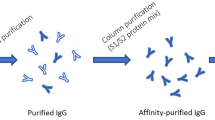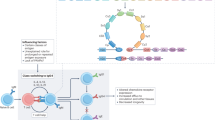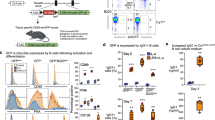Abstract
INTEREST in immunoglobulin fragments in serum centres around their antigenic sites which stimulate autoantibody1, and the insight they provide into the metabolism of immunoglobulins. They also have the potential to alter host immune defence mechanisms. For example, the F(ab′)2 fragment prepared in vitro from IgG is less effective than intact IgG in protecting animals injected with pathogens2, in aiding phagocytosis3,4 and in clearing bacteria from the blood stream2,5. Also, F(ab′)2 fragments are non-cytotoxic in the presence of complement6,7 and enhance the growth of tumours8,9. Because severely burned patients have larger than normal concentrations of proteolytic enzymes10 and immunoglobulins in their serum11–13, we regarded them as potential models for in vivo degradation of immunoglobulin, and examined serum from forty patients with 3–70 per cent body surface area full-thickness burns for immunoglobulin fragments. The following report identifies for the first time a serum F(ab′)2-like fragment in severely burned patients.
This is a preview of subscription content, access via your institution
Access options
Subscribe to this journal
Receive 51 print issues and online access
$199.00 per year
only $3.90 per issue
Buy this article
- Purchase on SpringerLink
- Instant access to full article PDF
Prices may be subject to local taxes which are calculated during checkout
Similar content being viewed by others
References
Lawrence, jun., T. G., and Williams, jun., R. C., J. Exp. Med., 125, 233 (1967).
Whitehouse, jun., F., Kilduff, J. T., and Christian, W., Bact. Proc., 51 (1964).
Whitehouse, jun., F., and Graber, C. R., Bact. Proc., 67 (1966).
Quie, P. G., Messner, R. P., and Williams, jun., R. C., J. Exp. Med., 128, 553 (1968).
Spiegelberg, H. L., Miescher, P. A., and Benacerraf, B., J. Immunol., 90, 751 (1963).
Whitehouse, jun., F., and Kilduff, J. T., J. Immunol., 97, 386 (1966).
Whitehouse, jun., F., and Broder, S., Proc. Soc. Exp. Biol. and Med., 127, 1064 (1968).
Broder, S., and Whitehouse, jun., F., Science, 162, 1494 (1968).
Chard, T., Immunology, 14, 583 (1968).
Zamecnik, P. C., Stephenson, M. L., and Cope, O., J. Biol. Chem., 158, 135 (1945).
Tubiana, R., in Research in Burns (edit. by Wallace, A. B., and Wilkinson, A. W.), 92 (Livingston, Edinburgh, 1966).
Kukral, J. C., and Boswick, J. A., J. Trauma, 7, 122 (1967).
Arturson, G., Hogman, C. F., Johansson, S. G. O., and Killander, J., Lancet, i, 546 (1969).
Procedures, Techniques and Apparatus for Electrophoresis, 49 (Gelman Instrument Co., Ann Arbor, 1968).
Whitehouse, jun., F., and Ulrich, G., Proc. Soc. Exp. Biol. and Med., 100, 792 (1959).
Nisonoff, A., Wissler, F. C., Lipman, L. N., and Woernley, D. L., Arch. Biochem. Biophys., 89, 230 (1960).
Schachman, H. K., in Methods in Enzymology, IV (edit. by Colowick, S. P., and Kaplan, N. O.), 52 (Academic Press, New York, 1957).
Nisonoff, A., Markus, G., and Wissler, F. C., Nature, 189, 293 (1961).
Kabat, E. A., Structural Concepts in Immunology and Immunochemistry, 163 (Holt, Rinehart and Winston, New York, 1968).
Feller, I., Vial, A. B., Callahan, W., and Waldyke, J., J. Trauma, 4, 451 (1964).
Feller, I., and Pierson, C., Arch. Surg., 97, 225 (1968).
Janeway, C. A., Merler, E., Rosen, F. S., Salmon, S., and Crain, J. D., New. Engl. J. Med., 278, 919 (1968).
Furstenbuerg, H. S., Bruns' Beitrage zur Klinischen Chir., 212, 481 (1966).
Skvaril, F., Nature, 185, 175 (1960).
Connell, G. E., and Painter, R. H., Canad. J. Biochem., 44, 371 (1966).
Graber, P., and Burtin, P., Immunoelectrophoretic Analysis, 162, 229 (Elsevier, Amsterdam and New York, 1964).
Osterland, C. K., Harboe, M., and Kunkel, H. G., Vox Sang., 8, 133 (1963).
Porath, J., and Ui, N., Biochim. Biophys. Acta, 90, 324 (1964).
Gavrilescu, K., and Kohn, J., Protides of Biological Fluids, 14, 373 (1966).
Whitehouse, jun., F., Goldberg, C. B., Broder, S., and Cassidy, J. T., Fed. Proc., 29, 503 abs. (1970).
Author information
Authors and Affiliations
Rights and permissions
About this article
Cite this article
GOLDBERG, C., WHITEHOUSE, F. F(ab′)2-like Fragments from Severely Burned Patients provide a New Serum Immunoglobin Component. Nature 228, 160–162 (1970). https://doi.org/10.1038/228160a0
Received:
Revised:
Issue date:
DOI: https://doi.org/10.1038/228160a0
This article is cited by
-
Deleterious Mutations and Neutral Substitutions
Nature (1971)



